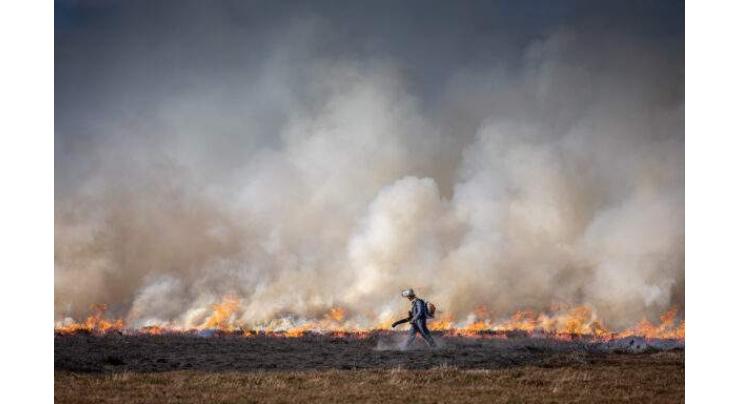
Greenpeace UK Warns Of Fires Deliberately Lit On England's Carbon-Rich Peatlands
Muhammad Irfan Published October 12, 2021 | 07:33 PM

Over 100 fires have been lit to burn heather on northern England's carbon-rich peatlands to maintain the ecosystem for grouse hunting, in spite of a partial ban and the government's commitment to cut emissions ahead of the upcoming UN Conference on Climate Change (COP26), Greenpeace UK warned on Tuesday
LONDON (UrduPoint News / Sputnik - 12th October, 2021) Over 100 fires have been lit to burn heather on northern England's carbon-rich peatlands to maintain the ecosystem for grouse hunting, in spite of a partial ban and the government's commitment to cut emissions ahead of the upcoming UN Conference on Climate Change (COP26), Greenpeace UK warned on Tuesday.
According to the Unearthed, an investigative journalism section of the environmental organization, the vast majority of the fires has been set on shallow peatlands, which are not covered by the ban.
The online publication cited Richard Lindsay, head of Environmental and Conservation Research at the University of East London, who questioned the British government for calling on countries such as Indonesia and Malaysia to stop burning its peatland, while allowing England's hills to be set on fire "in the name of sport.
"
Unearthed also asserted that restoring the UK's heavily degraded peatlands must be a top priority if the UK is to reach net zero emissions by 2050, as they account for 5% of the country's total carbon emissions.
Peatlands are waterlogged environments where plants decay very slowly and which are capable of storing vast amounts of carbon, but when degraded through overgrazing, draining for agriculture or pollution, they switch to being net emitters of planet-warming CO2.
However, the director of the Moorland Association, Amanda Anderson, told Unearthed that heather burning is permitted between October and April on shallow peat, and the technique used only burns the heather and not the peat below it.
Related Topics
Recent Stories

Experts raise concerns over introduction of 10-stick packs

Iranian president arrives in Karachi

Law Minister expresses Govt's resolve to address issue of missing persons

Rizwan’s batting order may be changed: Sources

Nawaz Sharif to visit Guangzhou exhibition in China

FM Dar not traveling to China: Foreign Office

PM takes notice of deliberate delay in tax cases

Iranian President visits Allama Iqbal’s mausoleum

Iranian President arrives in Lahore today

Currency Rate In Pakistan - Dollar, Euro, Pound, Riyal Rates On 23 April 2024

Today Gold Rate in Pakistan 23 April 2024

Islam enlightened world with its teachings about knowledge: Dr Jamileh
More Stories From World
-
French artist JR downsizes at Venice Biennale with Orient Express
1 hour ago -
Umrah & Ziarah Forum 2024: A gateway to enhance pilgrimage services in Holy land
1 hour ago -
16 dead, 28 missing in migrant boat capsize off Djibouti: UN
1 hour ago -
16 dead, 28 missing in migrant boat capsize off Djibouti: UN
2 hours ago -
How UK's biggest water supplier sank into crisis
2 hours ago -
EU lawmakers greenlight new rules to rein in national spending
2 hours ago
-
Hamas to stay in Doha if 'useful' for Gaza war mediation: Qatar
3 hours ago -
London stock market strikes record as sentiment lifts globally
3 hours ago -
In Brazil, hopes to use AI to save wildlife from roadkill fate
4 hours ago -
Taiwan hit by dozens of strong aftershocks from deadly quake
4 hours ago -
Ambassador Hashmi visits Linyi city in Shandong province
4 hours ago -
Norway women bring seaweed to culinary heights in Europe
4 hours ago